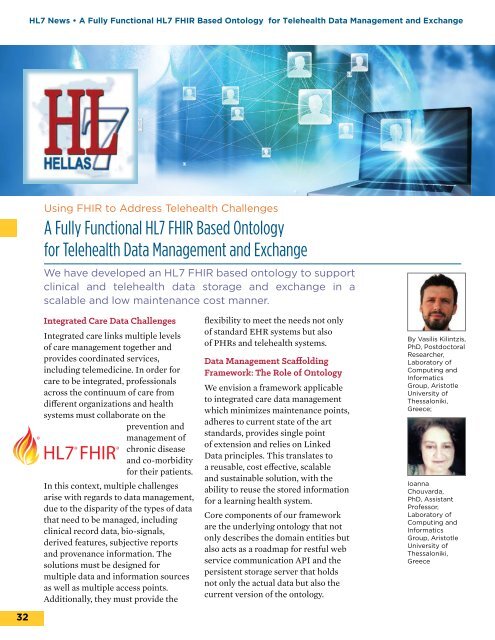In this Issue HL7 News
2cndmS4
2cndmS4
You also want an ePaper? Increase the reach of your titles
YUMPU automatically turns print PDFs into web optimized ePapers that Google loves.
<strong>HL7</strong> <strong>News</strong> • A Fully Functional <strong>HL7</strong> FHIR Based Ontology for Telehealth Data Management and Exchange<br />
Using FHIR to Address Telehealth Challenges<br />
A Fully Functional <strong>HL7</strong> FHIR Based Ontology<br />
for Telehealth Data Management and Exchange<br />
We have developed an <strong>HL7</strong> FHIR based ontology to support<br />
clinical and telehealth data storage and exchange in a<br />
scalable and low maintenance cost manner.<br />
<strong>In</strong>tegrated Care Data Challenges<br />
<strong>In</strong>tegrated care links multiple levels<br />
of care management together and<br />
provides coordinated services,<br />
including telemedicine. <strong>In</strong> order for<br />
care to be integrated, professionals<br />
across the continuum of care from<br />
different organizations and health<br />
systems must collaborate on the<br />
prevention and<br />
management of<br />
chronic disease<br />
and co-morbidity<br />
for their patients.<br />
<strong>In</strong> <strong>this</strong> context, multiple challenges<br />
arise with regards to data management,<br />
due to the disparity of the types of data<br />
that need to be managed, including<br />
clinical record data, bio-signals,<br />
derived features, subjective reports<br />
and provenance information. The<br />
solutions must be designed for<br />
multiple data and information sources<br />
as well as multiple access points.<br />
Additionally, they must provide the<br />
flexibility to meet the needs not only<br />
of standard EHR systems but also<br />
of PHRs and telehealth systems.<br />
Data Management Scaffolding<br />
Framework: The Role of Ontology<br />
We envision a framework applicable<br />
to integrated care data management<br />
which minimizes maintenance points,<br />
adheres to current state of the art<br />
standards, provides single point<br />
of extension and relies on Linked<br />
Data principles. This translates to<br />
a reusable, cost effective, scalable<br />
and sustainable solution, with the<br />
ability to reuse the stored information<br />
for a learning health system.<br />
Core components of our framework<br />
are the underlying ontology that not<br />
only describes the domain entities but<br />
also acts as a roadmap for restful web<br />
service communication API and the<br />
persistent storage server that holds<br />
not only the actual data but also the<br />
current version of the ontology.<br />
By Vasilis Kilintzis,<br />
PhD, Postdoctoral<br />
Researcher,<br />
Laboratory of<br />
Computing and<br />
<strong>In</strong>formatics<br />
Group, Aristotle<br />
University of<br />
Thessaloniki,<br />
Greece;<br />
Ioanna<br />
Chouvarda,<br />
PhD, Assistant<br />
Professor,<br />
Laboratory of<br />
Computing and<br />
<strong>In</strong>formatics<br />
Group, Aristotle<br />
University of<br />
Thessaloniki,<br />
Greece<br />
32



